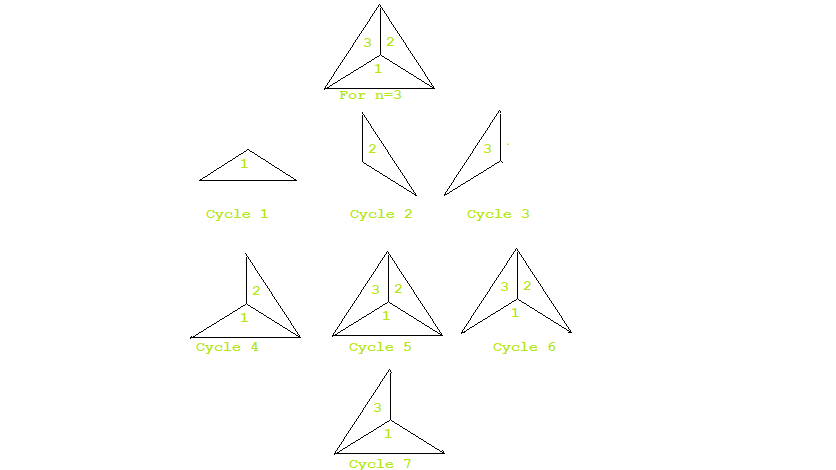给定一个N边的规则多边形,我们将所有顶点连接到了多边形的中心,从而将多边形分为N个相等的部分。我们的任务是对多边形中的循环总数进行计数。
注意:循环是在同一点开始和结束的闭环。
例子:
Input: N = 3
Output: 7
Explanation:

When a 3 sided polygon is connected by vertices at the center then we get 7 cycles possible for it as shown in the image.
Input: N = 5
Output: 21
Explanation:

When a 5 sided polygon is connected by vertices at the center then we get 21 cycles possible for it as shown in the image.
方法:对于上述问题,我们应该计算除法后给定多边形中可能存在的闭环总数。该方法基于数学模式。由于多边形的划分,将已经创建了N个循环。 N个块中的一个将与其余(N – 1)个块形成一个循环。其余(N – 1)个块将与其他(N – 2)个块形成循环。因此,可以使用以下公式找出我们的总循环数:
Total Cycles = N + 1 * (N – 1) + (N – 1) * (N – 2)
Total Cycles = 2 * N – 1) + (N – 1) * (N – 2)
下面是上述方法的实现:
C++
// C++ program for the above approach
#include
using namespace std;
// Function to calculate number of cycles
int findCycles(int N)
{
int res = 0;
int finalResult = 0;
int val = 2 * N - 1;
// BigInteger is used here
// if N=10^9 then multiply
// will result into value
// greater than 10^18
int s = val;
// BigInteger multiply function
res = (N - 1) * (N - 2);
finalResult = res + s;
// Return the final result
return finalResult;
}
// Driver code
int main()
{
// Given N
int N = 5;
// Function Call
cout << findCycles(N) << endl;
return 0;
}
// This code is contributed by divyeshrabadiya07 Java
// Java program for the above approach
import java.util.*;
import java.math.*;
class GFG {
// Function to calculate number of cycles
static BigInteger findCycles(int N)
{
BigInteger res, finalResult;
long val = 2 * N - 1;
String st = String.valueOf(val);
// BigInteger is used here
// if N=10^9 then multiply
// will result into value
// greater than 10^18
BigInteger str = new BigInteger(st);
String n1 = String.valueOf((N - 1));
String n2 = String.valueOf((N - 2));
BigInteger a = new BigInteger(n1);
BigInteger b = new BigInteger(n2);
// BigInteger multiply function
res = a.multiply(b);
finalResult = res.add(str);
// Return the final result
return finalResult;
}
// Driver Code
public static void
main(String args[]) throws Exception
{
// Given N
int N = 5;
// Function Call
System.out.println(findCycles(N));
}
}Python3
# Python3 program for the above approach
# Function to calculate number of cycles
def findCycles(N):
res = 0
finalResult = 0
val = 2 * N - 1;
# BigInteger is used here
# if N=10^9 then multiply
# will result into value
# greater than 10^18
s = val
# BigInteger multiply function
res = (N - 1) * (N - 2)
finalResult = res + s;
# Return the final result
return finalResult;
# Driver Code
if __name__=='__main__':
# Given N
N = 5;
# Function Call
print(findCycles(N));
# This code is contributed by pratham76C#
// C# program for the above approach
using System;
class GFG {
// Function to calculate number of cycles
static int findCycles(int N)
{
int res = 0;
int finalResult = 0;
int val = 2 * N - 1;
// BigInteger is used here
// if N=10^9 then multiply
// will result into value
// greater than 10^18
int s = val;
// BigInteger multiply function
res = (N - 1) * (N - 2);
finalResult = res + s;
// Return the final result
return finalResult;
}
// Driver code
static void Main()
{
// Given N
int N = 5;
// Function Call
Console.WriteLine(findCycles(N));
}
}
// This code is contributed by divyesh072019Javascript
输出:
21